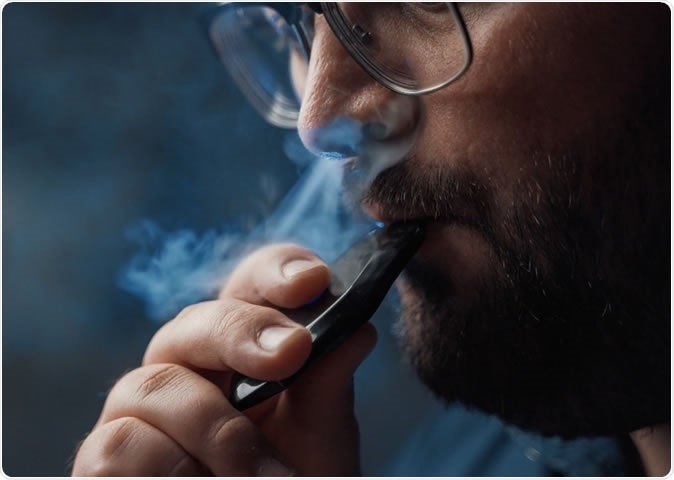With hundreds of people falling ill, and eight people dead, from a serious vaping-related lung illness, public concern has shot sky-high.

Image Credit: DedMityay / Shutterstock
Immune cells called macrophages, which engulf and cordon off dead or disabled cells, viruses and bacteria, and other foreign matter from the airways, are also affected by this vapor. The combination of increased cell death and lower disposal of waste matter predisposes to the buildup of these materials within the airway, causing airway inflammation, a possible mechanism of lung damage as a result of vaping.

Macrophage engulfing tuberculosis bacteria Mycobacterium tuberculosis, 3D illustration Credit: Kateryna Kon / Shutterstock
Among the many victims of the vaping-related epidemic, one frequent finding is the clogging up of cells by fat vacuoles, especially inside macrophages, which are primarily responsible for hauling away unwanted stuff inside the cell. This discovery by the Centers for Disease Control and Prevention (CDC) has already led to the call by the American Medical Association (AMA) to stop the practice of vaping at least until the cause of the illness is known.
How vaping injures the lung
The bronchial epithelium is made up of cells that line and protect the lung airways. These keep the airways and lungs free of debris and mucus, sweeping out waste with their microscopic brush-like cilia. Normally, cells in the various organs of the body die and are replaced. This occurs via a process called apoptosis whereby old or disabled cells enter a programmed pattern of elimination without releasing toxins or waste into their surroundings. E-liquid vapor increases the rate of apoptosis in the bronchial epithelium.
Previous studies by the same team showed that the vapor slows down the lung macrophages that patrol the air sacs. E-liquid vapor reduces the number of surface molecules on the macrophage that recognize and attach to specific bacterial matter. A species of bacterium called nontypeable Hemophilus influenzae (NTHi) is known to be the organism most commonly found in chronic obstructive pulmonary disease (COPD). Macrophages affected by vaping don’t clear this pathogen very well either.
The current study also revealed is that macrophages also do poorly at removing dead airway cells – a process called efferocytosis – with the rate falling to 10% -13% compared to the normal 21% in controls. This was shown to be due to the reduced production of various cell receptors which promotes recognition of the dead cells, the efferocytic receptors, when the macrophages are exposed to the apple-flavored vaping liquid or the PG base alone. Different apple flavored varieties showed different effects on some of these receptors. None of these liquids contained nicotine, however. Thus the effect on efferocytosis is “nicotine-independent and flavor-dependent”, though nicotine also causes a similar effect by itself.
In fact, the glycol base mirrored many of the effects of the vaping liquid, including a fall in cytokine levels. The extent of cytokine reduction in response to vaping liquid varies with the type of cell examined and the type of flavor. A poor cytokine response could affect the inflammatory response leading to increased severity and duration of infections in vivo.
Vaping on the loose
The study comes as over 500 young men have been hospitalized with the same mysterious but debilitating complaints following vaping. This shows that government regulation needs to be tightened up, say the researchers. E-cigarettes contain a liquid, which is basically propylene glycol (PG), vegetable glycerine (VG) or a mixture. The liquid contains some type of flavoring – most often fruity, minty or candy – as well as nicotine, in some brands. The flavoring is typically safe for use in food. The nicotine concentration is not fixed. Cannabis has been found in some e-cigarettes.
Since apple and other fruity flavors are extremely popular among vapers, the researchers looked at three varieties of apple-flavored vaping liquid. They found that while e-liquid manufacture was completely unregulated, the labeling was also left to the manufacturer’s discretion. It is not mandatory to list either the constituents or the quantities of each ingredient in the e-liquid.
Thus even two varieties with the identical flavor, such as chocolate or mint, need to contain the same type of flavoring agent, and even if they do, the concentrations can be wildly different. However, both the type and the amount of flavoring agent can make a huge difference in the toxicity of the e-cigarette vapor. Moreover, the safety of these substances in vapor form has hardly ever been tested. When we are told that only safe ingredients are used, what is meant is that the substances used have been tested for safety in edible form, mostly. But their effect on the lungs is practically unknown.
The take-home message
In effect, vaping means exposing the body to a large number of hitherto untested substances through the lungs. Not only are the lungs extremely vulnerable to damage, but they offer an incredibly large amount of surface area whereby living tissue can be damaged. As such, it is impossible to predict the toxicity of vaping at present. Rather than being a much safer practice than cigarette smoking, it could be far worse, caution the researchers.
Older studies have already proved that e-cigarettes cause harm to the lung, enhance the occurrence of dangerous oxygen radicals that damage membranes and DNA, reduce the rate of replication of tissue cells, prevent the blood vessel lining from forming an effective barrier to foreign substances in the air entering the lungs, and can produce symptoms closely resembling asthma. Some studies in mice show increased vulnerability to viral infection. The varying quality of the mouse studies and the wide range of e-liquid vapor has made the applicability of these studies more difficult.
The implications of the current study must be viewed against the background of the former announcement from Public Health England that smoking is 95% more dangerous than vaping. And some scientists say the current furore over vaping could lead people to go back to smoking traditional cigarettes again. Many vapers say they first took to e-cigarettes to help them quit or reduce smoking, or as a substitute. However, many have also taken to cigarettes following their introduction to vaping.
The government, both at federal level and in some states, are seriously considering a ban on flavored e-cigarettes, which are proving to be intensely attractive especially to young adults and teenagers. Teenage vaping has more than doubled over the past two years. Meanwhile, the giant supermarket chain Walmart has removed e-cigarettes from its US stores.
The study was published in the journal Respirology.
Journal reference:
Ween, MP, Hamon, R, Macowan, MG, Thredgold, L, Reynolds, PR, Hodge, SJ. Effects of E‐cigarette E‐liquid components on bronchial epithelial cells: Demonstration of dysfunctional efferocytosis. Respirology. 2019; 1– 9. https://doi.org/10.1111/resp.13696, https://onlinelibrary.wiley.com/doi/abs/10.1111/resp.13696